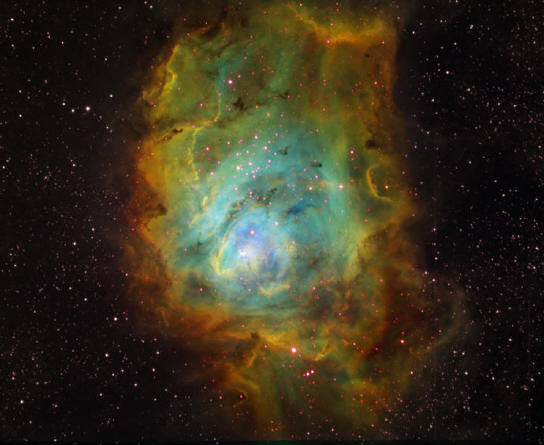For August 2013, the waning crescent moon passes four degrees south of Jupiter in the dawn skies on August 3rd, and then five degrees south of Mars on August 4th. The thin crescent sits 4 degrees south of Mercury on August 5th, and the moon is new on August 6th. The waxing crescent moon passes 5 degrees south of Venus in the evening
twilight on August 9th, and will be setting well before midnight on August 12th, when the Perseid meteor shower peaks with about a meteor a minute out of the NE from midnight until dawn. The waxing crescent moon passes three degrees south of Saturn on August 13th, and is first quarter the following evening. The moon is full, the Green Corn Moon in American Indian
tradition, on August 21st. The last quarter moon rises about midnight on August 28th, and passes five degrees south of Jupiter in the dawn sky on August 31st.
Mercury will be briefly visible in the morning sky in the first week of August, but vanishes behind the sun by mid August. Venus continues to dominate the evening sky, but is still on the far side of the sun, appearing as a bright, featureless gibbous disk in the telescope this month. Saturn is higher in the SW sky, just east of bright
Spica in Virgo. Enjoy the rings, now 17 degree open and tilted toward earth and sun; the most beautiful planet falls closer to the western horizon each evening, to be lost in the sunís glare in September. Jupiter is now in the morning sky in Gemini, rising about 3 AM at midmonth, and Mars is even farther east in Cancer in the dawn sky.
The Big Dipper rides high in the NW at sunset, but falls lower each evening. Good scouts know to take its leading pointers north to Polaris, the famed Pole Star. For us, it sits 30 degrees (our latitude) high in the north, while the rotating earth beneath makes all the other celestial bodies spin around it from east to west.
Taking the arc in the Dipperís handle, we "arc" SE to bright orange Arcturus, the brightest star of Spring. Cooler than our yellow Sun, and much poorer in heavy elements, some believe its strange motion reveals it to be an invading star from another smaller galaxy, now colliding with the Milky Way in Sagittarius in the summer sky. Moving
almost perpendicular to the plane of our Milky Way, Arcturus was the first star in the sky where its proper motion across the historic sky was noted, by Edmund Halley.
Spike south to Spica, the hot blue star in Virgo. Look for Saturn to the upper right of Spica, and drawing closer to it night by night as Saturn revolves around the sun in its slow 30 year orbit. From Spica curve to Corvus the Crow, a four sided grouping. It is above Corvus, in the arms of Virgo, where our large scopes will show members of
the Virgo Supercluster, a swarm of over a thousand galaxies about 50 million light years away from us.
Hercules is overhead, with the nice globular cluster M-13 marked on your sky map and visible in binocs. It is faintly visible with the naked eye under dark sky conditions, and among the best binoc objects on the map back page when you download the SkyMap pdf file.
The brightest star of the northern hemisphere, Vega dominates the NE sky. Binoculars reveal the small star just to the NE of Vega, epsilon Lyrae, as a nice double. Larger telescopes at 150X reveal each of this pair is another close double, hence its nickname, the "double double"Öa fine sight under steady sky conditions.
Below Vega are the two bright stars of the Summer Triangle; Deneb is at the top of the Northern Cross, known as Cygnus the Swan to the Romans. It is one of the most luminous stars in our Galaxy, about 50,000 times brighter than our Sun. To the south is Altair, the brightest star of Aquila the Eagle. If you scan the Milky Way with binocs or
a small spotting scope between Altair and Deneb, you will find many nice open star clusters and also a lot of dark nebulae, the dust clouds from which new stars will be born in the future
To the south, Antares rises about the same time in Scorpius. It appears reddish (its Greek name means rival of Ares or Mars to the Latins) because it is half as hot as our yellow Sun; it is bright because it is a bloated red supergiant, big enough to swallow up our solar system all the way out to Saturnís orbit! Just above the tail of the
Scorpion are two fine naked eye star clusters, M-7 (discovered by Ptolemy and included in his catalog about 200 AD) and M-6, making one of the best binocular views in the sky. Your binoculars are ideally suited to reveal many fine open star clusters and nebulae in this region of our Galaxy.

East of the Scorpionís tail is the teapot shape of Sagittarius, which marks the heart of our Milky Way galaxy. Looking like a cloud of steam coming out of the teapotís spout is the fine Lagoon Nebula, M-8, easily visible with the naked eye. This stellar nursery is ablaze with new stars and steamers of gas and dust blown about in their
energetic births. Our image this month reveals the beauty and turbulence associated with the birth of new stars. In the same binocular field just north of the Lagoon is M-20, the Trifid Nebula. Just east of the pair is the fine globular cluster M-22, faintly visible to the naked eye and spectacularly resolved in scopes of 8" or larger aperture. It lies just to the
upper left of the star that marks the lip of the teapot shape of Sagittarius, so it is easy to spot in binocs as well.